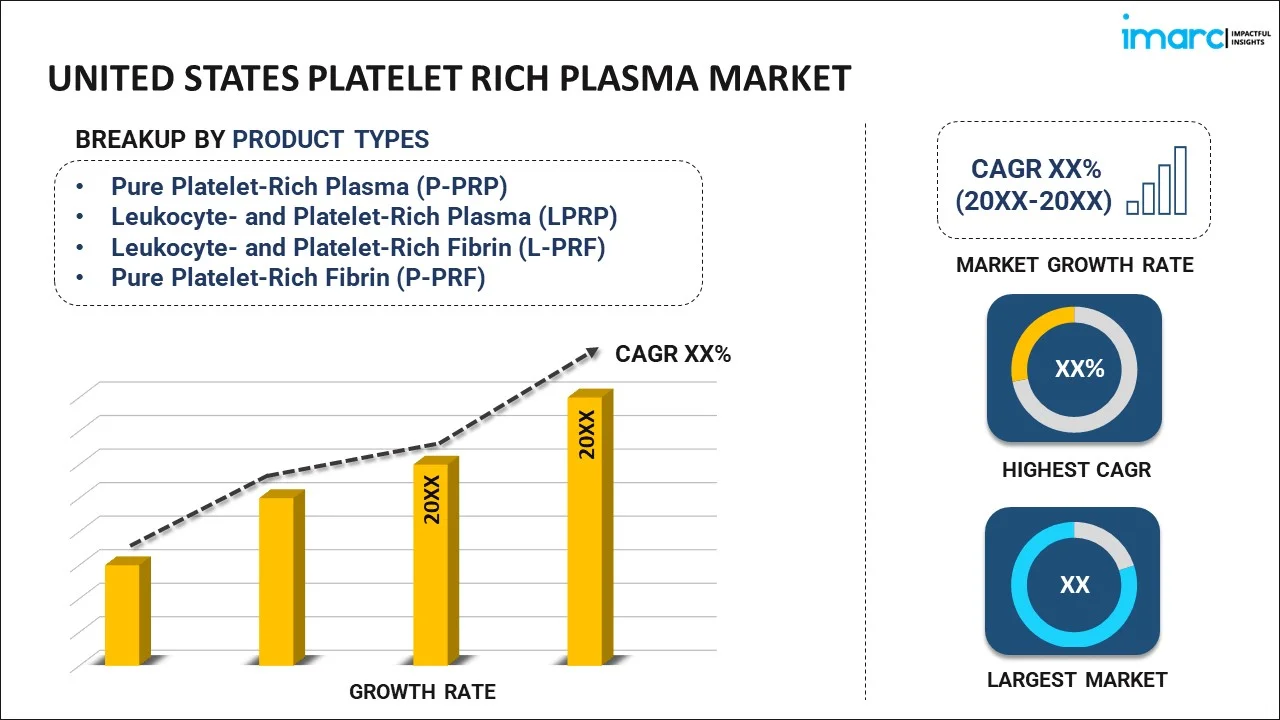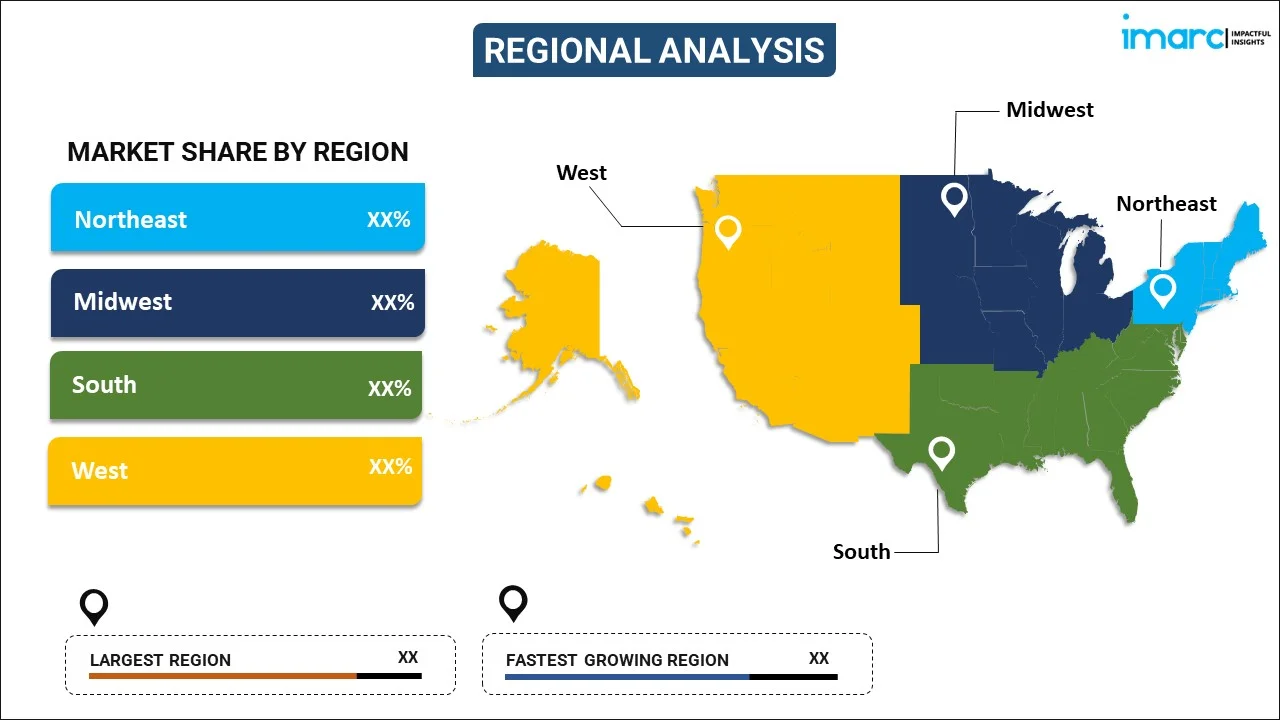
United States Platelet Rich Plasma Market Report by Product Type (Pure Platelet-Rich Plasma (P-PRP), Leukocyte- and Platelet-Rich Plasma (LPRP), Leukocyte- and Platelet-Rich Fibrin (L-PRF), Pure Platelet-Rich Fibrin (P-PRF)), Origin (Autologous PRP, Homologous PRP, Allogeneic PRP), Application (Orthopedics, Cosmetic Surgery and Dermatology, Neurosurgery, General Surgery, Cardiothoracic Surgery, Urology, Ophthalmology, and Others), End User (Hospitals and Clinics, Research Institutes, and Others), and Region 2025-2033
United States Platelet Rich Plasma Market Size, Share & Analysis:
The United States platelet rich plasma market size reached USD 271.7 Million in 2024. Looking forward, IMARC Group expects the market to reach USD 581.2 Million by 2033, exhibiting a growth rate (CAGR) of 8.38% during 2025-2033.
|
Report Attribute
|
Key Statistics
|
|---|---|
|
Base Year
|
2024
|
|
Forecast Years
|
2025-2033
|
|
Historical Years
|
2019-2024
|
|
Market Size in 2024
|
USD 271.7 Million |
|
Market Forecast in 2033
|
USD 581.2 Million |
| Market Growth Rate (2025-2033) | 8.38% |
United States platelet rich plasma Market Analysis:
- Key Market Trends: Platelet-rich plasma is gaining traction across orthopedics, aesthetics, and sports medicine, driven by regenerative medicine growth and patient demand for non-surgical, natural healing approaches in clinical and cosmetic applications.
- Major Drivers: Increased preference for minimally invasive treatments, advancements in PRP preparation systems, growing awareness of regenerative therapies, and the rising number of sports injuries and chronic musculoskeletal conditions support market momentum thus aiding the United States platelet rich plasma market growth.
- Market Challenges: Lack of standardized protocols, inconsistent clinical outcomes, limited reimbursement coverage, and regulatory ambiguity pose barriers to broader adoption and confidence in platelet-rich plasma applications across different medical fields.
- Market Opportunities: Expanding clinical research, development of user-friendly devices, growth in aesthetic and veterinary uses, and partnerships among biotech firms and clinics create avenues for innovation and wider PRP market penetration.
United States platelet rich plasma Market Trends:
Growing Demand for Minimally Invasive and Regenerative Therapies
The rising preference for minimally invasive treatments is a key driver of the United States platelet rich plasma market trends. Patients and healthcare providers increasingly seek therapies that promote natural healing without surgical intervention. PRP, derived from the patient's own blood, fits well within regenerative medicine due to its potential to accelerate tissue repair, reduce inflammation, and enhance recovery. This demand is particularly high in orthopedics, sports medicine, and aesthetics, where patients aim to avoid the risks and downtime of surgery. Additionally, the aging population is contributing to a higher incidence of degenerative conditions such as osteoarthritis, further boosting interest in regenerative approaches like PRP. The therapy's low risk of immunogenic response and its personalized nature appeal to both providers and patients, making it a preferred option across multiple specialties seeking non-invasive, effective alternatives.
Technological Advancements in PRP Preparation Systems
Advancements in PRP processing technology have significantly improved the consistency, efficiency, and safety of PRP treatments, thus driving market adoption in the U.S. Modern automated centrifuge systems and closed-loop devices have streamlined PRP extraction, allowing for better control of platelet concentration and preparation time. These developments improve reproducibility, lower operator error, and increase procedure accessibility in office-based or outpatient settings. Furthermore, physicians from a variety of specialties, such as dentistry, orthopedics, and dermatology, can now employ PRP with no training thanks to easy-to-use kits. Depending on the clinical indication, customized applications are now possible thanks to the discovery of leukocyte-rich and leukocyte-poor PRP variants. As technology continues to evolve, the standardization of PRP products becomes more achievable, supporting wider clinical use and improving patient outcomes. These technological strides make PRP not only more practical but also more appealing as a mainstream therapeutic tool.
Rising Incidence of Sports Injuries and Musculoskeletal Disorders
The growing number of sports-related injuries and musculoskeletal conditions in the United States platelet rich plasma market analysis. Active lifestyles, especially among young adults and aging baby boomers, contribute to a high prevalence of tendonitis, ligament tears, and joint degeneration. PRP is widely used in sports medicine to accelerate healing and reduce downtime in athletes, both amateur and professional. Likewise, orthopedic conditions such as osteoarthritis and chronic back pain affect millions, prompting interest in alternatives to steroids and surgery. PRP has shown promise in reducing pain and improving function in these patients by enhancing the body’s natural healing processes. Its ability to delay or replace invasive interventions makes it attractive in both preventative and therapeutic contexts. This rising burden of musculoskeletal disorders ensures a strong and growing demand for innovative biologic treatments like PRP.
Key Market Segmentation:
IMARC Group provides an analysis of the key trends in each sub-segment of the United States platelet rich plasma market report, along with forecasts at the country level from 2025-2033. Our report has categorized the market based on product type, origin, application, and end user.
Breakup by Product Type:

To get more information on this market, Request Sample
- Pure Platelet-Rich Plasma (P-PRP)
- Leukocyte- and Platelet-Rich Plasma (LPRP)
- Leukocyte- and Platelet-Rich Fibrin (L-PRF)
- Pure Platelet-Rich Fibrin (P-PRF)
Breakup by Origin:
- Autologous PRP
- Homologous PRP
- Allogeneic PRP
Breakup by Application:
- Orthopedics
- Cosmetic Surgery and Dermatology
- Neurosurgery
- General Surgery
- Cardiothoracic Surgery
- Urology
- Ophthalmology
- Others
Breakup by End User:
- Hospitals and Clinics
- Research Institutes
- Others
Breakup by Region:

- Northeast
- Midwest
- South
- West
Competitive Landscape:
The competitive landscape of the industry has also been examined with some of the key players being Arteriocyte Medical Systems Inc. (Isto Technologies II LLC), Arthrex Inc., Depuy Synthes, Inc. (Johnson & Johnson), Dr Prp USA LLC, EmCyte Corporation, Exactech Inc., Glofinn America LLC (Glofinn Co. Ltd.), Regen Lab USA LLC, Stryker Corporation, Terumo BCT Inc. (Terumo Corporation), ThermoGenesis Holdings Inc. and Zimmer Biomet Holdings Inc.
Latest News and Developments:
- In July 2024, Crown Aesthetics, a division of Crown Laboratories, acquired select assets and technology from Healeon LLC, a subsidiary of Bimini Health Tech. This strategic move strengthens Crown’s leadership in the PRP aesthetics space, enhancing its ProGen PRP® Eclipse brand and expanding its global footprint. The acquisition supports Crown’s mission of delivering advanced, research-backed skincare solutions while deepening customer partnerships and accelerating innovation in regenerative aesthetic treatments.
Report Coverage:
| Report Features | Details |
|---|---|
| Base Year of the Analysis | 2024 |
| Historical Period | 2019-2024 |
| Forecast Period | 2025-2033 |
| Units | Million USD |
| Segment Coverage | Product Type, Origin, Application, End User, Region |
| Region Covered | Northeast, Midwest, South, West |
| Companies Covered | Arteriocyte Medical Systems Inc. (Isto Technologies II LLC), Arthrex Inc., Depuy Synthes, Inc. (Johnson & Johnson), Dr Prp USA LLC, EmCyte Corporation, Exactech Inc., Glofinn America LLC (Glofinn Co. Ltd.), Regen Lab USA LLC, Stryker Corporation, Terumo BCT Inc. (Terumo Corporation), ThermoGenesis Holdings Inc. and Zimmer Biomet Holdings Inc. |
| Customization Scope | 10% Free Customization |
| Post-Sale Analyst Support | 10-12 Weeks |
| Delivery Format | PDF and Excel through Email (We can also provide the editable version of the report in PPT/Word format on special request) |
Key Questions Answered in This Report
The United States platelet rich plasma market was valued at USD 271.7 Million in 2024.
We expect the United States platelet rich plasma market to exhibit a CAGR of 8.38% during 2025-2033.
The rising consumer awareness towards numerous benefits associated with platelet rich plasma treatment, such as preventing inflammation, encouraging new cartilage formulation, inducing natural lubrication fluid production, etc., is primarily driving the United States platelet rich plasma market.
The sudden outbreak of the COVID-19 pandemic had led to the postponement of elective cosmetic, orthopedics, and neuro surgical procedures to reduce the risk of the coronavirus infection upon hospital visits and interaction with medical equipment, thereby negatively impacting the United States market for platelet rich plasma.
Based on the product type, the United States platelet rich plasma market has been divided into pure platelet-rich plasma (P-PRP), leukocyte- and platelet-rich plasma (LPRP), leukocyte- and platelet-rich fibrin (L-PRF), and pure platelet-rich fibrin (P-PRF). Among these, pure platelet-rich plasma (P-PRP) currently exhibits a clear dominance in the market.
Based on the origin, the United States platelet rich plasma market can be categorized into autologous PRP, homologous PRP, and allogeneic PRP. Currently, autologous PRP accounts for the majority of the total market share.
Based on the application, the United States platelet rich plasma market has been segregated into orthopedics, cosmetic surgery and dermatology, neurosurgery, general surgery, cardiothoracic surgery, urology, ophthalmology, and others. Among these, orthopedics currently exhibit a clear dominance in the market.
Based on the end user, the United States platelet rich plasma market can be bifurcated into hospitals and clinics, research institutes, and others. Currently, hospitals and clinics hold the largest market share.
On a regional level, the market has been classified into Northeast, Midwest, South, and West, where West currently dominates the United States platelet rich plasma market.
Some of the major players in the United States platelet rich plasma market include Arteriocyte Medical Systems Inc. (Isto Technologies II LLC), Arthrex Inc., Depuy Synthes, Inc. (Johnson & Johnson), Dr Prp USA LLC, EmCyte Corporation, Exactech Inc., Glofinn America LLC (Glofinn Co. Ltd.), Regen Lab USA LLC, Stryker Corporation, Terumo BCT Inc. (Terumo Corporation), ThermoGenesis Holdings Inc., and Zimmer Biomet Holdings Inc.
Need more help?
- Speak to our experienced analysts for insights on the current market scenarios.
- Include additional segments and countries to customize the report as per your requirement.
- Gain an unparalleled competitive advantage in your domain by understanding how to utilize the report and positively impacting your operations and revenue.
- For further assistance, please connect with our analysts.
 Request Customization
Request Customization
 Speak to an Analyst
Speak to an Analyst
 Request Brochure
Request Brochure
 Inquire Before Buying
Inquire Before Buying




.webp)




.webp)












